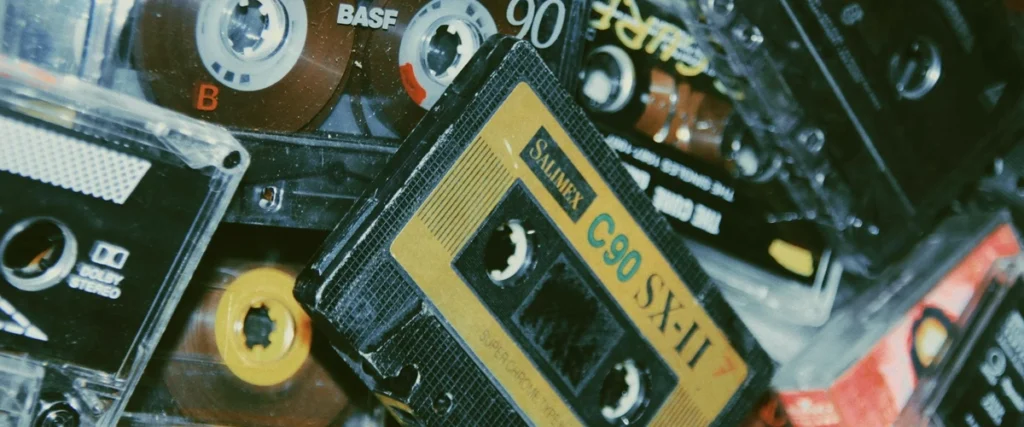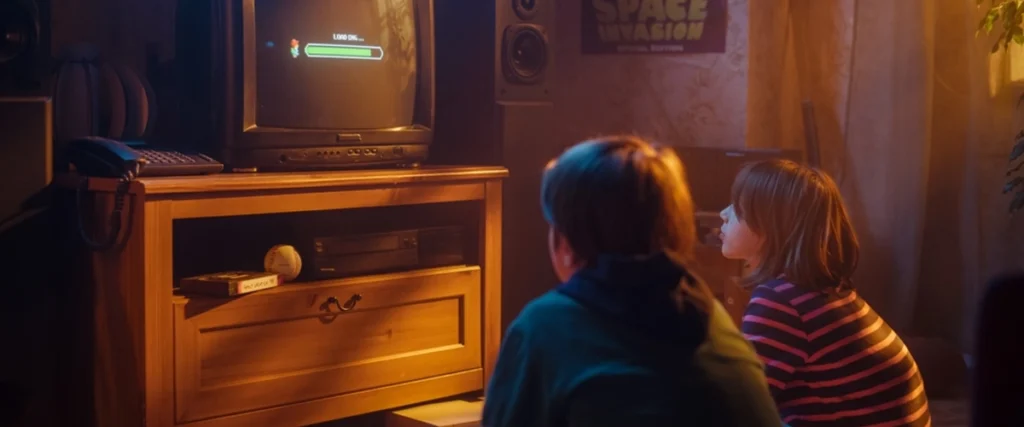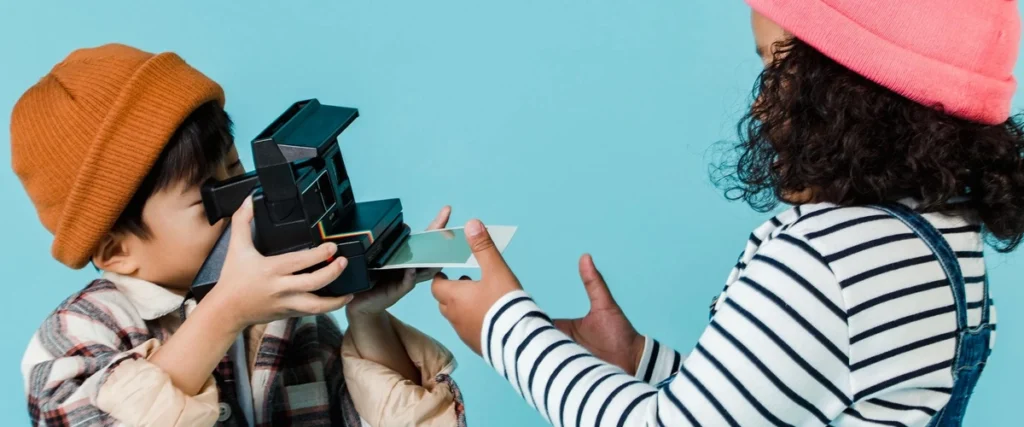It’s hard not to be punny when talking about Nostalgia Marketing — since it’s a strategy that stands the test of time while diving back in time. Maybe punny isn’t right. Maybe it’s like some “Quantum Leap” level hocus-pocus ploy that reminds us of those “magic times” when ice cream was 25 cents a scoop, sunburns weren’t a health crisis, and Santa was real. (Oops. Spoiler alert.)
We’re talking about Nostalgia Marketing because it’s becoming a thing again, from logo revivals to catchy jingles to vintage filters layered on photos and videos.
Plus, we’re seeing (and loving) nostalgia experiential marketing pop-ups that are essentially nostalgia theme parks. Who wouldn’t want to spend a bit of time with Dorothy, Rose, Blanche, of Sophia at The Golden Girls Experience? What about a cocktail in the Stranger Things bar? Sign us up for a weekend of escape and fun.
Let’s be clear — we’re here for it because it works in B2C and B2B environments. It’s a strategy that both pulls at heartstrings and opens purse strings. Plus, it’s fun and lets brands and businesses stand out in these noisy days.
We’re also seeing new products branded and marketed with vintage flair utilizing a strategy called “Nowstalgia.” The tactic’s visual and message storytelling aims to resonate with an audience’s perceptions of a bygone era, not something that they’ve actually experienced. Ever wonder why a Millennial shopper is looking for vinyl? Yep, that’s “Nowstalgia.”
Let’s get into it.

Everyone’s Obsessed with the “Good Ol’ Days”
Some of us hearken back to the “Good Ol’ Days” when music came on vinyl, hashtags were pound signs, and video games were handheld hunks of plastic with vertical lines representing players.
Others dream of crew cuts and poodle shirts, long hair and bra-burning, disco and cocaine … No matter the cultural signifier, we look back on those days with rose-tinted glasses and yearn for an “easier” time.
Our current digital lifestyle—there are so many beeps in our homes now that it’s hard to figure out if the coffee is ready, the refrigerator is open, the dishwasher is finished, or the garage door is opening—makes the allure of a quieter, less distracted time stronger than ever.
Nostalgia marketing makes certain cultural touchstones, like Nintendo games and the old Pepsi logo, feel like home. Boomers reminisce about Suzy Homemaker toys, Gen X about Walkmans, and Millennials can’t stop thinking about how to keep their Tamagotchi alive.
Here’s the thing — leveraging nostalgia in marketing is a delicate art. You can’t just throw a vintage filter on your ad and call it good, expecting everyone to get misty-eyed over your product.
Before launching your Nostalgia campaign, you must do these things:
- Look at your current brand — can it authentically connect to the past? (Sure, Tesla can connect to The Jetsons, but can …. Actually, just about everything from AI to robot vacuums connects to The Jetsons.)
- Research your ideal customer profile to understand what cultural touchstones are relevant. Then, target the right audience with the right campaigns.
- Take a deep dive into the connection between ICP and touchstone, ensuring you’re shining a spotlight on a positive experience for all. Plus, make sure you know why something is resonating. Random example: Jello-O mold salads were the thing in the 70s. Why does that matter to people buying that product now?
- Do the homework and validate the authenticity of your work — nothing turns an audience off faster than faking it.
- Watch the clock — this marketing tactic is meant as a break, not an ongoing strategy.
We can’t stress enough the importance of audience research and targeting. Why would you try to talk to the generation that became music fans through iTunes using the language of the generation that saved their allowance to buy a record?
Yet, using the past as a launching pad to connect and resonate more deeply with your audience can bring those folks buying Crosley portable record players and the revamped iPod Nano into your world.
A generation’s core memories are the secret to crafting campaigns that transport your audience back to those moments while subtly whispering, “Hey, remember us?”
A word of caution — be careful when you tap into the nostalgia factor. From movies to video games, we’re all experiencing a series of reboots and remakes. Did we really need a new “Roadhouse?” No. Don’t just slap a vintage filter on something new. Don’t force feelings. Avoid nostalgia-baiting.
When we evoke memories and avoid cheap gimmicks, we all win.

B2B Nostalgia — It’s Not Just for Hipsters
Nostalgia isn’t just for B2C brands — it can also work wonders in the B2B world. Yes, even in the land of boardrooms and bottom lines, the “good ol’ days” can still resonate with CEOs and bean counters.
If you think about it, B2B decision-makers are people, too — with emotional triggers that can influence their choices. Behind almost every operations manager or c-suite executive is someone who may have recorded a favorite television show on VHS or waited patiently by the radio to hear their favorite song.
Tapping into these fond memories can transform your brand from just another vendor to a trusted partner.
Tread lightly, friend. It’s a short jump in B2B marketing to go from wistful nostalgia to cheesiness. Aim for subtlety. Look for your ICP’s nostalgic references and hint at those times rather than hammer the point.
Because B2B solutions can feel cold and technical, adding a human element makes your brand more relatable and approachable. Forbes found that 71% percent of buyers will continue purchasing a B2B product or service if they see personal value.
By highlighting your brand’s history and legacy, referencing past trends or technologies, and reinforcing your evolution as a company, you can create a sense of continuity and reliability that can help solidify your relationships and show that your solutions have only improved with age.
Feel free to modernize nostalgic elements. Staying attuned to cultural trends and integrating nostalgic elements can make B2B marketing feel familiar and fresh — a perfect strategy for attracting new clients and keeping repeat customers warm and fuzzy.
Loyalty is everything in the B2B world. With some nostalgia marketing, you strengthen that loyalty by reminding your partners and clients of the shared journey you’ve been on together. It’s about celebrating how far your company has come while acknowledging the path and the people that got you there.
Nostalgia marketing might only be a good fit for some organizations. Remember, if you do use it, brand authenticity is critical.
Layering in aspects of nostalgia marketing will connect on a deeper level with your potential customers than any standard business jargon.

Nowstalgia — The New Kid on the Old Block
“Nowstalgia” is not a typo but a concept about engaging younger people who want to return to an imagined past — Gen-Z and younger Millennials yearning for a time they never experienced.
Coined by Leah Carrol from the BBC, Nowstalgia is more for the generations that came after the original trend. It’s not a past that has happened to them, but it’s something they inherently yearn to experience.
Today, it’s young people with old souls armed with smartphones and social media who seek out typewriters, record players, and film and 35mm cameras for photography.
Brands are on board with this trend in a big way. Have you wondered why today’s record players have Bluetooth compatibility? How about Polaroid cameras with a selfie feature? Yep—vintage vibes with modern convenience.
Why does it matter? Because it shows us that consumers are looking to connect with experiences they remember (nostalgia marketing) and experiences they’ve heard about (nowstalgia).
Nostalgia cycles typically run in 20-to-30-year patterns. So, Nowstalgia is also a way to create multigenerational marketing campaigns — a product or a service based on something an older generation grew up on, with a modern twist for the younger generation who want to live in a similar, but imagined, past.
You don’t even need a time machine to make the past relevant. You need a good story and a little bit of creativity. With Nowstalgia marketing, you can create a sense of heritage — building on the past for a fresh, innovative experience for your target audience.
Lisa Frank made Millennials nostalgic for the 1970s with their lava lamps and mood rings — now Gen-Z is nostalgic for all things Y2K. It’s all about striking that delicate balance between “Aww, I remember that!” and “Wow, that’s cool again!”
This trend helps remind audiences of good times while being excited about how those good times are reinventing themselves. It’s a clever trick, and frankly, it works wonders.
Nowstalgia highlights your brand’s ability to innovate, evolve, and push boundaries while maintaining a timelessness that creates a unique experience for your audience.

Helping you Navigate The World of Nostalgia Marketing
Navigating the world of nostalgia marketing can feel like trying to recreate that perfect childhood bowl of cereal – remembering the exact ratio of milk to cereal and hoping you won’t end up with a soggy mess.
That’s where Farinella comes in, your trusty sidekick in this adventure. Our team has an uncanny ability to help you craft a marketing strategy that will conjure that warm fuzzy feeling from the past that resonates with your brand and your audience without making it seem like you’re grasping at youth with desperation.
Unlike VHS footage, our campaigns are clear, strategically sound, and designed to resonate with your audience.
Let’s make sure your marketing features style AND substance. Drop us a line.
